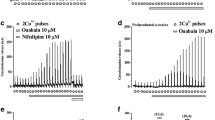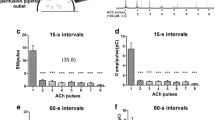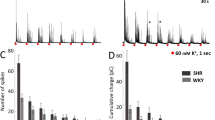Abstract
The effect of several calmodulin antagonists on the release of α-amylase (EC 3.2.1.1) from rat parotid gland minces was investigated as an approach to determine whether calmodulin has a role in the stimulus-secretion coupling mechanism in this tissue. The phenothiazines, trifluoperazine, chlorpromazine, and thioridazine, failed to inhibit amylase release induced by N6, O2′-dibutyryl adenosine 3′:5′-cylic monophosphate. All three phenothiazine increased basal amylase release at high concentrations. This release was independent of cellular energy, indicating that the release was probably due to the membrane perturbing properties of these compounds rather than their ability to antagonize calmodulin. R24571, a more potent calmodulin antagonist, also failed to inhibit amylase release induced by N6, O2′-dibutyryl adenosine 3′:5′-cyclic monophosphate but increased basal amylase release. A different calmodulin antagonist, N-(6-aminohexyl)-5-chloro-1-naphthalenesulfonamide, partially inhibited release while 8-(N,N-diethylamino)-octyl 3,4,5-trimethoxybenzoate hydrochloride (TMB-8) completely blocked the amylase release induced by the cyclic AMP derivative. However, concentrations of TMB-8 inhibiting amylase release drastically reduced the ATP concentration of rat parotid minces, suggesting that the inhibition of secretion was due to toxic effects of TMB-8 on parotid cells rather than the ability of the compound to antagonize calmodulin. The use of calmodulin antagonists has therefore failed to implicate calmodulin as an intermediate in the stimulus-secretion coupling mechanism of the rat parotid gland.
Similar content being viewed by others
References
Addanki S, Sotos JF, Rearick PD (1966) Rapid determination of picomole quantities of ATP with a liquid scintillation counter. Anal Biochem 14:261–264
Alobaidi T, Naccache PH, Sha'afi RI (1981) Calmodulin antagonists modulate neutrophil degranulation, aggregation and stimulated oxygen consumption. Biochim Biphys Acta 675:316–321
Bdolah A, Ben-Zvi R, Schramm M (1964) The mechanism of enzyme secretion by the cell. II. Secretion of amylase and other proteins by slices of rat parotid gland. Arch Biochem Biophys 104:58–66
Bernfeld P (1955) Amylase α and β. Methods Enzymol 1:149–158
Butcher FR (1978) Calcium and cyclic nucleotides in the regulation of secretion from the rat parotid by autonomic agonists. Adv Cyclic Nucleotide Res 9:707–721
Butcher FR (1980) Regulaton of calcium efflux from isolated rat parotid cells. Biochim Biophys Acta 630:254–260
Butcher FR, Putney JW Jr (1980) Regulation of parotid gland function by cyclic nucleotides and calcium. Adv Cyclic Nucleotide Res 13: 215–249
Cheung WY (1980) Calmodulin plays a pivotal role in cellular regulation. Science 207:19–27
Elferink JGR (1979) Chlorpromazine inhibits phagocytosis and exocytosis in rabbit polymorphonuclear leukocytes. Biochem Pharmacol 28:965–968
Heisler S, Chauvelot L, Desjardins D, Noel C, Lambert H, Desy-Audet L (1981) Stimulus-secretion coupling in exocrine pancreas: possible role of calmodulin. Can J Physiol Pharmacol 59:994–1001
Hidaka H, Yamaki T, Asano M, Totsuka T (1978) Invovement of calcium in cyclic nucleotide metabolism in human vascular smooth muscle. Blood Vessels 15:55–64
Ku KY, Butcher FR (1980) Detection of a calmodulin-sensitive cyclic nucleotide phosphodiesterase in rat parotid gland. Biochim Biophys Acta 631:70–78
Lowry OH, Rosebrough NJ, Farr AL, Randall RJ (1951) Protein measurement with the Folin phenol reagent. J Biol Chem 193: 265–275
Malagodi MH, Chiou CY (1974) Pharmacological evaluation of a new Ca2+ antagonist, 8-(N,N-diethylamino)octyl 3,4,5-trimethoxybenzoate hydrochloride (TMB-8): studies in skeletal muscles. Pharmacology 12:30–31
Means AR, Dedman JR (1980) Calmodulin — an intracellular calcium receptor. Nature 285:73–77
Naccache PH, Molski TFP, Alobaidi T, Becker EL, Showell HJ, Sha'afi RI (1980) Calmodulin inhibitors block neutrophil degranulation at a step distal from the mobilization of calcium. Biochem Biophys Res Comm 97:62–68
Piascik MF, Rahwan RG, Witiak DT (1978) Pharmacological evaluation of new calcium antagonists: 2-substituted 3-dimethylamino-5,6-methylenedioxyindenes. Effects on adrenomedullary catecholamine secretion. J Pharmacol Exp Ther 205:155–163
Piascik MT, Johnson CL, Potter JD, Rahwan RG (1981) Binding of the Ca2+ antagonist, 2-butyl-3-dimethylamino-5,6-methylenedioxyindene (butyl-MDI), to calmodulin (CAM). Fed Proc 40:1740
Putney JW Jr, Weiss SJ, Leslie BA, Marier SH (1977) Is calcium the final mediator of exocytosis in the rat parotid gland? J Pharmacol Exp Ther 203:144–155
Rahwan RG, Faust MM, Witiak DT (1977) Pharmacological evaluation of new calcium antagonists: 2-substituted 3-dimethylamino-5,6-methylenedioxyindenes. J Pharmacol Exp Ther 201:126–137
Schubart UK, Fleischer N, Erlichman J (1980) Ca2+-dependent protein phosphorylation and insulin release in intact hamster insulinoma cells. Inhibition by trifluoperazine. J Biol Chem 255:11063–11066
Seeman PM (1966) Membrane stabilization by drugs: tranquilizers, steroids, and anesthetics. Int Rev Neurobiol 9:145–221
Selinger Z, Naim E (1970) The effect of calcium on amylase secretion by rat parotid slices. Biochim Biophys Acta 203:335–337
Smith RJ, Iden SS (1979) Phorbol myristate acetate-induced release of granule enzymes from human neutrophils: inhibition by the calcium antagonist, 8-(N,N-diethylamino)-octyl 3,4,5-trimethoxybenzoate hydrochloride. Biochem Biophys Res Comm 91:263–271
Smolen JE, Korchak HM, Weissmann G (1981) The roles of extracellular and intracellular calcium in lysosomal enzyme release and superoxide anion generation by human neutrophils. Biochim Biophys Acta 677:512–520
Stolzenbach F (1966) Lactic dehydrogenase (crystalline). Methods Enzymol 9:278–288
Sugden MC, Christie MR, Ashcroft SJH (1979) Presence and possible role of calcium-dependent regulator (calmodulin) in rat islets of Langerhans. FEBS Lett 105:95–100
Van Belle H (1981) R24571: A potent inhibitor of calmodulin-activated enzymes. Cell Calcium 2:483–494
Weiss B, Greenberg LH (1980) Modulation of β-adrenergic receptors and calmodulin following acute and chronic treatment with neuroleptics. Adv Biochem Psychopharmacol 24:139–146
Weiss B, Levin RM (1978) Mechanism for selectively inhibiting the activation of cyclic nucleotide phosphodiesterase and adenylate cyclase by antipsychotic agents. Adv Cyclic Nucleotide Res 9: 285–303
Zografi G, Auslander DE (1965) Surface activity of chlorpromazine and chlorpromazine sulfoxide in the presence of insoluble monomolecular films. J Pharmacol Sci 54:1313–1318
Author information
Authors and Affiliations
Additional information
This work was supported in part by Grant AM-25249 from the National Institutes of Health
Rights and permissions
About this article
Cite this article
Spearman, T.N., Butcher, F.R. The effect of calmodulin antagonists on amylase release from the rat parotid gland in vitro. Pflugers Arch. 397, 220–224 (1983). https://doi.org/10.1007/BF00584361
Received:
Accepted:
Issue Date:
DOI: https://doi.org/10.1007/BF00584361




